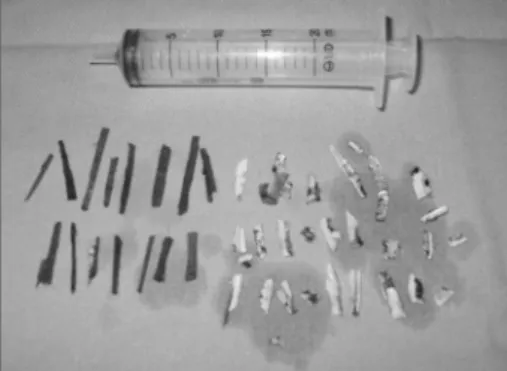948
Brazilian Journalof otorhinolaryngology 74 (6) novemBer/DecemBer 2008 http://www.rborl.org.br / e-mail: revista@aborlccf.org.br
CASE REPORT
34 Self-inflicted Foreign
Bodies in the Maxillary Sinus
Márcio Meira Lima1, Camila Alencar Moreira2, Viviane
Carvalho da Silva3, Marcos Rabelo de Freitas4
INTRODUCTION
Foreign bodies (FB) are a common occurrence in the realm of ENT practice. The most commonly involved sites are nasal cavities, ears, and pharynx. Foreign bodies are accompanied by site-related symptoms and do not pose much of a chal-lenge to well-trained physicians. Foreign bodies may be introduced willingly by the patient or by accident1,2.
Paranasal sinus foreign bodies are rarely seen, and most of them are intro-duced accidentally (25%) or iatrogenically (60%). The latter may occur as a conse-quence of dental, ophthalmic, and otorhi-nolaryngological procedures. The maxillary sinus is more frequently involved (75%), followed by the frontal sinus (18%)3,4.
Only a few cases of self-inoculated paranasal sinus foreign body have been reported in the literature. This paper reports a case of chronic sinusitis secondary to the inoculation of multiple foreign bodies in the maxillary sinus.
CASE REPORT
M.C., 49, sought ENT care com-plaining of nasal obstruction, halitosis, cacosmia, purulent rhinorrhea, and post-nasal drip for three years. Nasal fibroscopy showed a hypertrophied middle nasal concha to the right and a deviated septum (+++/4+) in Cottle’s area III convex to the
left. The left middle meatus had a small number of polyps and thick purulent se-cretion. No signs of oroantral fistula were seen under oroscopy. The patient was diagnosed with chronic rhinosinusitis and was prescribed levofloxacin, 500mg/day orally for 21 days, prednisone, 40mg/day for 6 days and progressively lower dosages for up to 10 days, and nasal flushing with saline solution.
The patient improved only margi-nally. A CT scan of the paranasal sinuses was done after the patient followed the treatment described above. The maxillary sinuses were filled and the right middle concha was bullous. Functional endoscopic surgery was offered to the patient.
During left maxillary antrostomy multiple pieces of wood and plastic were found inside the sinus, and the operation had to be converted to an external appro-ach using the Caldwell-Luc procedure to allow for better visualization of the antrum. Thirty-four foreign bodies were removed from the left maxillary sinus. Some of them broke into smaller pieces during surgical manipulation, and that is why on Figure 1 their number is larger. No foreign bodies were found on the right maxillary sinus. The day after surgery the patient revealed that he had undergone a dental extraction five years before, and that he began to voluntarily introduce foreign bodies in his sinus through an oroantral fistula. He
sho-wed no evident signs of mental disorder and could communicate normally. The patient improved dramatically from the symptoms, and post-nasal dripping persis-ted only for a few weeks after surgery.
DISCUSSION
Foreign bodies in the paranasal sinuses are rare, but are an integral part of the differential diagnosis for rhinosinusitis, mainly when it occurs unilaterally. When symptoms appear at later stages, the most frequent complaints are indicative of chro-nic rhinosinusitis5.
The patient at hand had both maxillary sinuses involved. The foreign bodies precipitated the onset of left sinus
disease. CT scans revealed bone failure on the floor of the left maxillary sinus, proba-bly connected to the previously existing oroantral fistula. No foreign bodies were found on the right side, and the patient’s anatomic alteration (bullous middle con-cha) was probably the reason why this sinus was involved.
The Caldwell-Luc procedure com-bined with the endoscopic approach has been described as the golden standard for the treatment of various diseases of the maxillary sinus including foreign bodies, particularly when complete resolution cannot be achieved by functional endos-copic surgery6.
CONCLUSION
Foreign bodies in the paranasal sinuses are rare. Oroantral fistulas are the most common inoculation path, mainly those secondary to dental procedures. The Caldwell-Luc procedure is the appro-ach of choice to address this condition, mainly when it cannot be treated endos-copically.
REFERENCES
1. Marques MPC, Sayuri MC, Nogueira MD, Nogueirol RB, Maestri VC. Tratamento dos corpos estranhos otorrinolaringológicos: um estudo prospectivo. Rev Bras Otorrinolaringol 1998;64:42-7.
2. Tiago MPC, Salgado DC, Correa JP, Pio MRB, Lambert EE. Corpo estranho de orelha, nariz e orofaringe: experiência de um hospital terciário. Rev Bras Otorrinolaringol 2006;72:177-81. 3. Krause HR, Rustemeyer J, Grunert RR. Foreign
body in paranasal sinuses. Mund Kiefer Gesi-chtschir 2002;6(1):40-4.
4. Liston PN, Walters RF. Foreign bodies in the maxillary antrum: a case report. Aust Dent J 2002;47(4):344-6.
5. Tingsgaard PK, Larsen PL. Chronic unilateral maxillary sinusitis caused by foreign bo-dies in the maxillary sinus. Ugeskr Laeger 1997;7(28):4402-4.
6. Friedlich J, Rittenberg BN. Endoscopically assis-ted Caldwell-Luc Procedure for Removal of a Foreign Body From the Maxillary Sinus. J Can Dental Assoc 2005;71:200-1.
Keywords: foreign body, maxillary sinus, sinusitis.
1 MD, Otorhinolaryngologist at Hospital Geral do Exército de Fortaleza.
2 MD, Resident Physicial at the Otorhinolaryngology Service at Hospital Universitário Walter Cantídio - Universidade Federal do Ceará.
3 MSc in Public Health at Universidade Federal do Ceará, Assistant Physician in the Otorhinolaryngology Service at Hospital Universitário Walter Cantídio - Universidade Federal do Ceará. 4 PhD in Medical Sciences at Universidade Federal do Ceará, Assistant Professor in the Otorhinolaryngology Program at Universidade Federal do Ceará.
This paper was submitted to the RBORL-SGP (Publishing Manager System) on 10 February 2007. code 3659. The article was accepted on 28 March 2007.
Rev Bras Otorrinolaringol 2008;74(6):948.
